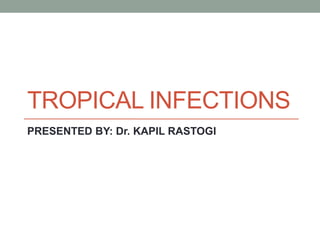Tropical infections
- 1. TROPICAL INFECTIONS PRESENTED BY: Dr. KAPIL RASTOGI
- 2. 1- DENGUE 2- MALARIA 3- TYPHOID 4- SCRUB TYPHUS 5- LEPTOSPIROSIS etc.
- 3. âĒ Fever with thrombocytopenia âĒ Antipyretics for control of fever âĒ IV fluids âĒ Avoid aspirin/anticoagulants âĒ Watch for bleeding, dyspnoea, shock âĒ Platelet transfusion if the platelet count<20,000 or âĒ clinical bleeding âĒ No role of steroids âĒ Specific therapy once the diagnosis is established
- 4. âĒFever with jaundice âĒ Antipyretics for control of fever âĒ Injection ceftriaxone 2 g IV BD âĒ Tablet doxycycline 100 mg BD âĒ IV fluids âĒ Watch for urine output, seizures, encephalopathy, âĒ bleeding âĒ FFP/cryoprecipitate for bleeding âĒ Specific therapy once the diagnosis is established
- 5. âĒFever with renal failure âĒ Antipyretics for control of fever âĒ Injection ceftriaxone 2 g IV BD* âĒ Tablet doxycycline 100 mg BD* âĒ IV fluids according to CVP âĒ Watch for encephalopathy, bleeding, seizures, ARDS âĒ Renal replacement therapy (intermittent HD/CRRT) âĒ Specific therapy once the diagnosis is established
- 6. âĒFever with encephalopathy âĒ Antipyretics for control of fever âĒ Injection ceftriaxone 2 g IV BD* âĒ IV acyclovir 10 mg/kg in adults (up to 20 mg/kg in children) intravenously every 8 h âĒ IV fluids âĒ IV mannitol for raised ICP âĒ Watch for seizures âĒ Specific therapy once the diagnosis is established
- 7. âĒFever with Respiratory distress âĒ Antipyretics for control of fever âĒ IV fluids âĒ Oxygen by Venturi mask âĒ Injection ceftriaxone 2 g IV BD* âĒ Injection azithromycin 500 mg IV OD* âĒ Tablet oseltamivir 150 mg BD, if H1N1 is a possibility âĒ Watch for impending respiratory failure, shock, âĒ renal failure, alveolar hemorrhage âĒ Specific therapy once diagnosis is established
- 8. SPECIFIC INFECTIONS âĒDENGUE:Causative organism: Dengue virus (Flavivirus) âĒ serotypes 1-4. âĒ Vector: Aedes mosquitoes âĒ Dengue is endemic throughout India with a recent âĒ resurgence of epidemics over the past two decades.
- 9. âĒ CLINICAL FEATURES: âĒ : Incubation period 4-10 days: âĒ Dengue fever: âĒ Headache, retro-orbital pain, myalgia, arthralgia, rash âĒ Dengue Hemorrhagic fever: âĒ Thrombocytopenia (<100,000), skin, mucosal âĒ and gastrointestinal bleeds, third spacing, rise in hematocrit âĒ Dengue shock syndrome: âĒ Weak pulse, cold clammy extremities, pulse pressure âĒ < 20 mmHg, hypotension âĒ Expanded dengue syndrome: âĒ Encephalitis, myocarditis, hepatitis, renal failure, ARDS, âĒ hemophagocytosis.
- 10. âĒ Diagnosis: âĒ âĒ Nonstructural protein 1 antigen detection âĒ â Sensitivity 76-93%, SpeciïŽcity >98%. âĒ IgM, IgG serology (IgG titer > 1:1280 is 90% sensitive âĒ and 98% speciïŽc).
- 11. âĒTreatment: âĒ Isotonic fluid infusion just sufficient to maintain âĒ effective circulation during the period of plasma âĒ leakage; guided by serial hematocrit âĒ Blood transfusion is done only with overt bleeding/ âĒ rapid fall in hematocrit.
- 12. MALARIA âĒ Causative organism: Plasmodium protozoa (P. falciparum, âĒ Plasmodium vivax, Plasmodium malariae [Odisha]). âĒ Vector: Anopheles mosquito. âĒ Plasmodium species are unevenly distributed across India
- 13. âĒ Clinical features: âĒ Paroxysm of fever, shaking chills and sweats occur every âĒ 48 or 72 h, depending on species. Hepatosplenomegaly may be present.
- 14. âĒ Manifestations of severe malaria: âĒ âĒ Cerebral malaria (sometimes with coma) âĒ âĒ Severe anemia âĒ âĒ Hypoglycemia âĒ âĒ Metabolic acidosis âĒ âĒ Acute renal failure (serum creatinine > 3 mg/dl) âĒ âĒ ARDS âĒ âĒ Shock âĒ âĒ DIC âĒ âĒ Hemoglobinuria âĒ âĒ Hyperparasitemia (>5%)
- 15. âĒ Diagnosis: âĒ Microscopy: Thick smears â parasite detection; Thin smearsâ species identiïŽcation âĒ Rapid diagnostic tests (RDTs) â histidine rich âĒ protein, lactate dehydrogenase antigen based âĒ Malaria ruled out if two negative RDTs.
- 16. âĒ TREATMENT Drug of choice: Artesunate Dose: 2.4 mg/kg i.v. bolus at admission, 12 h and 24 h; followed by once a day for 7 days + Doxycycline 100 mg p.o. 12 hourly. Alternative: Quinine 20 mg/kg loading dose, followed by 10 mg/kg i.v. infusion 8 hourly + Doxycycline 100 mg p.o. 12 hourly.
- 17. ENTERIC FEVER âĒ âĒ Causative organism: Salmonella typhi, serovar âĒ paratyphi A, B or C âĒ âĒ Transmission: focally contaminated food and water âĒ âĒ Most prevalent in urban areas, with high incidence in âĒ children 15 years of age and younger.[30]
- 18. âĒ Clinical features: Incubation period 1-14 days. âĒ Manifestations: âĒ 1week - fever, headache, relative bradycardia âĒ 2nd week - Abdominal pain, diarrhea, constipation, âĒ hepatoslenomegaly, encephalopathy âĒ 3rd week - Intestinal bleeding, perforation, MODS
- 19. âĒ Diagnosis: âĒ Typhidot (RDT) â Sensitivity 95-97%, SpeciïŽ city > 89%, âĒ âĒ Widal test-non-speciïŽc âĒ Blood culture â Gold standard, positive in 40-80% of patients âĒ Bone marrow cultures â sensitivity 80-95%; may âĒ remain positive even after 5 days of pre-treatment
- 20. âĒTreatment: âĒ First line: Ceftriaxone i.v. 50-75 mg/kg/day for âĒ 10-14 days to cover MDR S. typhi. âĒ Azithromycin and CiproïŽoxacin are alternatives âĒ Consider dexamethasone 3 mg/kg followed by 1 mg/kg âĒ 6 hourly for 48 h in selected cases with encephalopathy, hypotension or DIC
- 21. JAPANESE ENCEPHALITIS âĒ Causative organism: Japanese encephalitis virus Vector: Culex tritaeniorhynchus Clinical features: Incubation period averages 6-8 days, with a range of 4-15 days. Prodromal period-fever, headache, vomiting and myalgia. Neurological features
- 22. âĒ Diagnosis: âĒ IgM capture ELISA Serum: sensitivity 85-93%, Specifcity âĒ 96-98%, CSF: Sensitivity 65-80%, SpeciïŽcity 89-100%. âĒ Treatment: âĒ Supportive-Airway management, seizure control and âĒ management of raised intracranial pressure.
- 23. THANK YOU











![MALARIA
âĒ Causative organism: Plasmodium protozoa (P. falciparum,
âĒ Plasmodium vivax, Plasmodium malariae [Odisha]).
âĒ Vector: Anopheles mosquito.
âĒ Plasmodium species are unevenly distributed across India](https://image.slidesharecdn.com/tropicalinfections-191206122017/85/Tropical-infections-12-320.jpg)




![ENTERIC FEVER
âĒ âĒ Causative organism: Salmonella typhi, serovar
âĒ paratyphi A, B or C
âĒ âĒ Transmission: focally contaminated food and water
âĒ âĒ Most prevalent in urban areas, with high incidence in
âĒ children 15 years of age and younger.[30]](https://image.slidesharecdn.com/tropicalinfections-191206122017/85/Tropical-infections-17-320.jpg)





